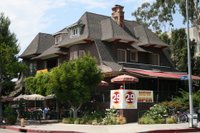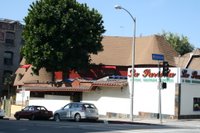Adaptive Abuse/Facade-ectomy (Part 1)
 Building Reuse or Adaptive Reuse is the process of adapting buildings to new primary uses whilst retaining historic or significant features. Valued for its economic, social, and environmental advantages, examples include Santa Monica's Bergamot Station (train yard turned art galleries), and downtown's many loft conversions. Previously, I featured a spectacular Shingle Style house in Highland Park, the Ziegler Estate, reborn as La Casita Verde, a day care and pre-school (see Shingle Style 7/26/2008 ).
Building Reuse or Adaptive Reuse is the process of adapting buildings to new primary uses whilst retaining historic or significant features. Valued for its economic, social, and environmental advantages, examples include Santa Monica's Bergamot Station (train yard turned art galleries), and downtown's many loft conversions. Previously, I featured a spectacular Shingle Style house in Highland Park, the Ziegler Estate, reborn as La Casita Verde, a day care and pre-school (see Shingle Style 7/26/2008 ). Adaptive reuse can help preserve buildings, and maintain a valued heritage; however, not all re-purposing exhibits sympathetic handling. Often structures are altered irreversibly and in uncomprehending fashion. Whereas the Ziegler Estate survives mostly intact, two other Shingle Style gems have been unforgivingly converted into restaurants. The Davis house (built in 1897) hosts a generally mediocre eatery, the 2-9 Cafe, near USC (top image); while, La Parilla in Westlake mars a magnificent form.
Adaptive reuse can help preserve buildings, and maintain a valued heritage; however, not all re-purposing exhibits sympathetic handling. Often structures are altered irreversibly and in uncomprehending fashion. Whereas the Ziegler Estate survives mostly intact, two other Shingle Style gems have been unforgivingly converted into restaurants. The Davis house (built in 1897) hosts a generally mediocre eatery, the 2-9 Cafe, near USC (top image); while, La Parilla in Westlake mars a magnificent form.The most controversial practice in preservation however, is the facade-ectomy.
(To be continued)
Labels: Preservation preach

1 Comments:
Found your blog today, Great!
John
Post a Comment
Comments
<< Home